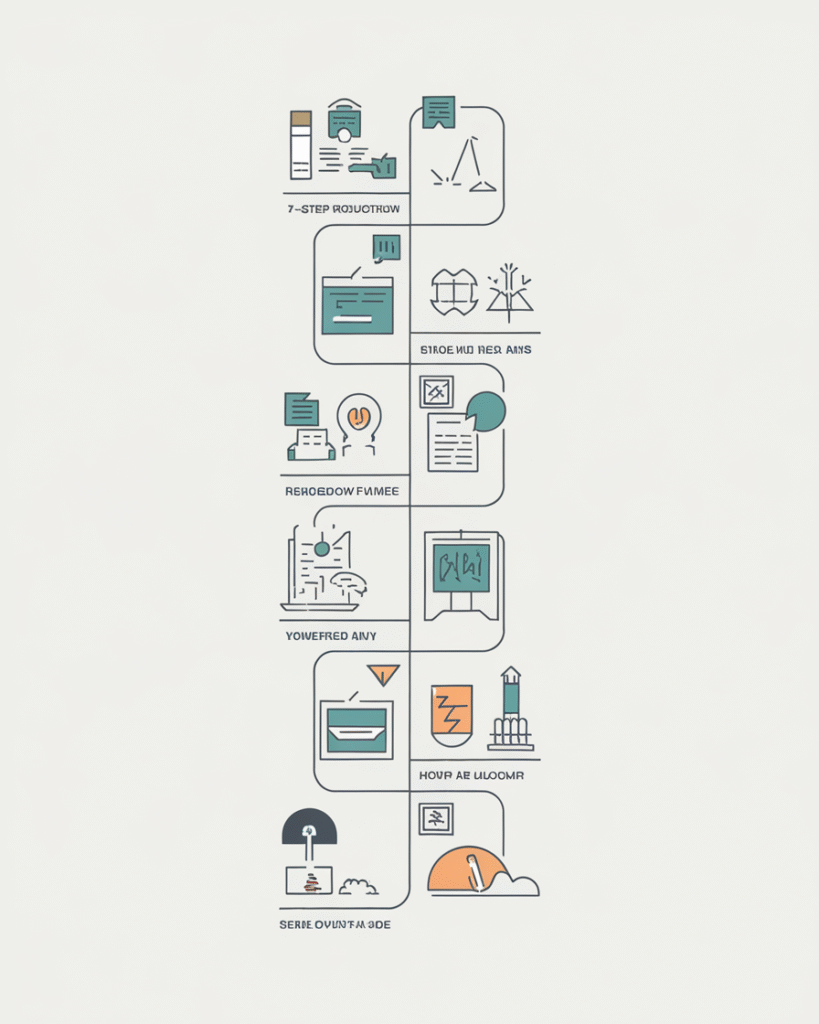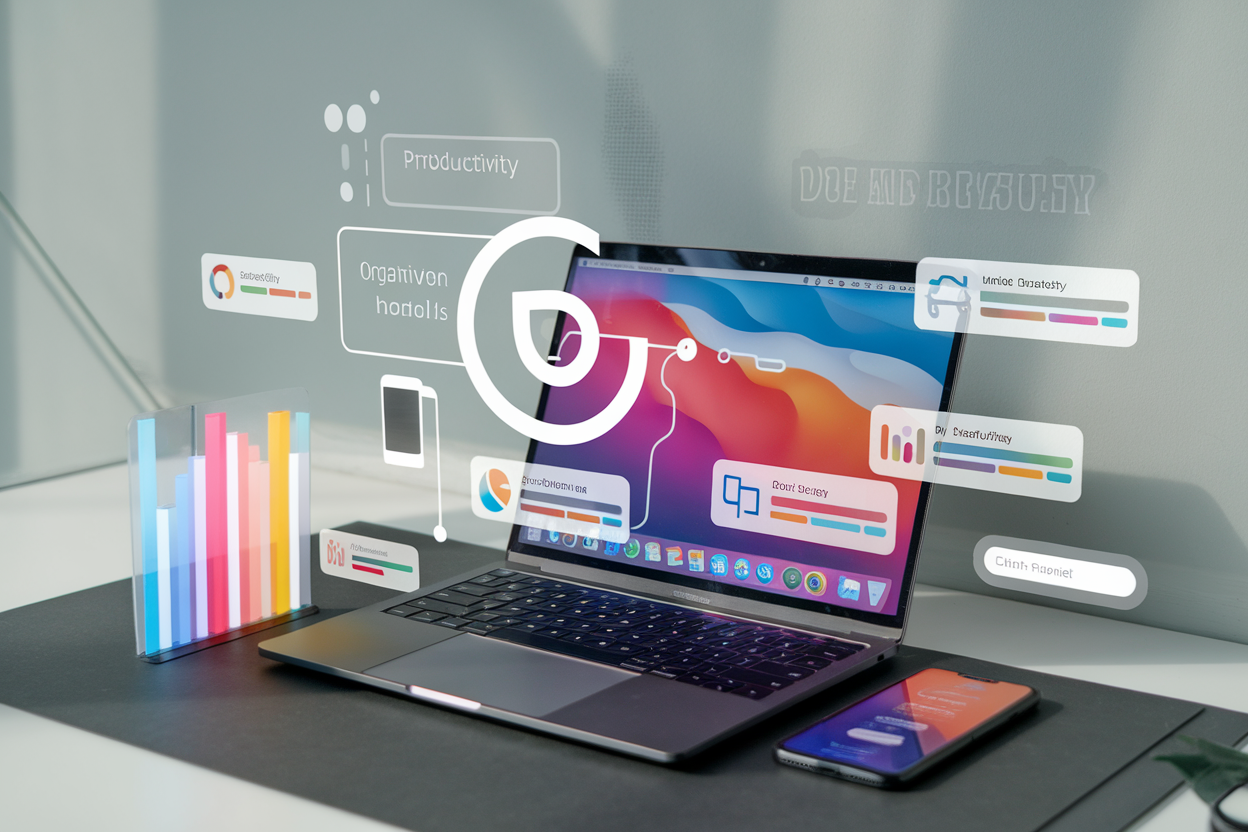AI tools are taking over the way we handle everyday tasks, and they’re doing it so well that many people are replacing 10 or more daily apps with just one or two smart assistants. If you’ve ever juggled too many apps, opened ten browser tabs just to write one blog post, or lost track of where your reminders live, you know the pain of app overload. AI tools were built to solve that exact problem.
These aren’t just tools that “help” you get things done. They do the things for you. And they’re doing it fast.
Let me tell you why I started this blog, RiseViaAI, and why I’m so passionate about sharing real, useful knowledge around AI tools. Like many of you, I was drowning in a daily digital mess. One app for writing, another for brainstorming, another for meetings, another for task management, and yet another for editing. It felt like my job was managing apps more than actually creating things.
I knew something had to change. When I first discovered AI tools like Notion AI, ChatGPT, and ClickUp AI, it felt like cheating. These tools combined multiple functions into one clean interface. They remembered what I needed. They saved hours a week. They were, frankly, better than everything else I was using.
This blog was born to help creators, small business owners, freelancers, students, and honestly, anyone who uses a screen every day to get work done. I wanted to create a space that makes AI tools simple to understand, easy to use, and powerful to apply. No jargon. No fluff. Just practical advice backed by experience.
Table of Contents
Table of Contents
Context & Evolution: How AI Tools Became the New Digital Workhorses
AI tools didn’t just appear overnight. They’re the result of years of evolution in how we interact with software. To appreciate why AI tools are replacing so many daily apps, we have to look at how we got here.
Back When We Needed 10 Different Apps
Let’s rewind to 2018 or so. Most people used at least a dozen separate tools to get through a workday. You might have opened Trello for tasks, Google Docs for writing, Grammarly for editing, Zoom for meetings, Slack for team chats, Canva for designs, and then tossed in Dropbox, Calendly, Notion, and a time-tracker for good measure.
This setup worked, sort of, but it was messy. Each app had its own learning curve. Notifications pulled you in ten different directions. Worst of all, none of these apps “talked” to each other in a way that felt smooth. You had to jump from screen to screen just to complete one project.
That chaos led to a new question: what if one app could do the job of many?
The Rise of Early AI Tools
Around 2020, we started to see AI enter the picture. Notion got smarter. Grammarly introduced tone detection. Email assistants began predicting your responses. But the big shift happened with the public launch of GPT-3, which made it possible for software to understand natural language and produce human-like output. This wasn’t just automation. These were true AI tools that could think and write and reason with you.
By 2022, companies began building full platforms around these AI engines. Instead of building apps that do one thing, they started building tools that do everything you tell them to—as long as you can type it.
That’s when people realized that AI tools could replace multiple apps at once. You no longer needed five separate tools. You just needed one that understood you.
AI Tools Today: Not Just Smart, but Strategic
Fast forward to 2025, and AI tools are everywhere. You’ve got:
- ClickUp AI managing tasks, writing updates, and creating systems
- Notion AI turning notes into action plans and ideas into polished documents
- ChatGPT doing everything from scripting YouTube videos to debugging code
- Claude and Perplexity summarizing PDFs, building content calendars, and doing in-depth research in seconds
These aren’t isolated apps. They’re central hubs that understand your workflow, remember your style, and can take an idea from start to finish without needing a dozen other apps to pitch in.
That’s what makes AI tools the future and the present of productivity.
Deep Dive: What Makes AI Tools Different from Traditional Apps?
So what exactly separates AI tools from traditional software apps? Why can a single AI assistant do what used to take five or ten apps to accomplish?
The answer lies in context, intelligence, and integration.
Traditional Apps vs AI Tools: A Side-by-Side Comparison
| Feature | Traditional Apps | AI Tools |
|---|---|---|
| Task scope | One function per app | Multiple functions in one |
| User input | Manual clicks, forms | Natural language prompts |
| Integration | Needs Zapier or plugins | Built-in smart workflows |
| Learning curve | Different for each app | One interface for everything |
| Adaptability | Static | Learns your style, adapts to your needs |
| Time savings | Moderate | Significant—up to 50% less time switching tools |
AI Tools Understand You (Without Training Wheels)
Instead of forcing you to click through menus and learn complicated dashboards, AI tools let you communicate in plain English (or your native language). You can type something like, “Draft a blog post based on this meeting note, create a 5-slide presentation, and schedule it to post next Thursday,” and the AI tool will understand the full request and execute each task using built-in functions.
That’s not a luxury. It’s a game-changer.
AI Tools Work Across Domains
One of the biggest advantages of AI tools is that they’re cross-functional. They aren’t tied to just one industry or use case.
For example, a teacher can use AI tools to create lesson plans, grade essays, and write parent emails. A small business owner can use the same tool to write product descriptions, generate ads, and manage a content calendar. A student can use it to summarize chapters, brainstorm essay ideas, and plan study schedules.
Instead of hopping between three different platforms, they just use one AI assistant.
AI Tools Are More Than Just Smart
They’re predictive. They’re generative. They’re customizable. And they’re constantly getting better.
The more you use AI tools, the better they understand your preferences, your voice, and your patterns. This isn’t like installing an app and using it the same way every time. These tools grow with you.
They also work across devices, platforms, and formats. You can use the same AI tools on desktop, mobile, or even inside your browser as an extension.
The difference is night and day. Once you start using AI tools the right way, going back to a cluttered app stack feels like going back to dial-up internet.
Real-World Applications & Impact of AI Tools Across Work and Life
The beauty of AI tools is how flexible they are. They don’t just live in one type of industry or help with one specific task. They show up everywhere in creative jobs, technical roles, daily errands, and even emotional labor like writing thoughtful emails. The impact of AI tools is massive because they take on small tasks that usually eat up your time and energy. And when they’re combined into one tool, that impact multiplies fast.
Let’s look at how AI tools are being used in the real world. These aren’t theories. These are actual ways that people, teams, and businesses are using AI tools every day.
1. Content Creators and Freelancers: One Tool for Everything
Take a freelance writer, for example. Before AI tools became part of their workflow, they probably used five different platforms to do their job. Google Docs for writing, Grammarly for editing, Hemingway for clarity, Notion for planning, and Canva for visuals.
Now? One AI tool like Notion AI or ChatGPT handles all of that. The writer types in a rough idea and gets a fleshed-out draft. Then they ask the tool to clean up the grammar, check for tone, and turn it into a LinkedIn post, a blog article, and even an Instagram caption. The visuals? Generated by another AI feature within the same tool. That’s five jobs done in one place. It saves time and brainpower and gives them more energy to focus on what matters—creating.
2. Teachers and Educators: From Burnout to Balance
AI tools are becoming a lifesaver for educators. Teachers use tools like MagicSchool.ai, Notion AI, or even free ChatGPT prompts to create lesson plans, quizzes, and emails to parents. Some are even using AI tools to translate content for multilingual students or adapt materials for kids with learning differences.
One high school teacher I interviewed uses AI tools to generate weekly classroom newsletters. It used to take her two hours. Now it takes 15 minutes. She repurposes that saved time to tutor students or just breathe for a moment between classes.
3. Startups and Solopreneurs: Building With Less Stress
If you run a small business, you know what it’s like to wear every hat. Marketing, sales, operations, customer service, content it’s a lot. But AI tools are becoming like a second brain for solopreneurs.
One digital product seller I know uses ChatGPT Pro with custom instructions to handle product descriptions, email marketing sequences, social media captions, and even basic customer support replies. It used to take her three days a week just to keep up with content. Now she does it all in a few hours and spends the rest of her time actually building her business.
4. Corporate Teams: Collaboration That Makes Sense
Big companies are using AI tools too. In marketing teams, tools like Jasper or Copy.ai are being used to create ad copy and run A/B tests. HR teams use AI assistants to screen resumes and write job descriptions. Even customer support teams are turning to tools like Forethought or Zendesk’s AI to suggest answers, summarize tickets, and route requests faster.
One manager I spoke with said their team reduced email volume by 30% just by implementing AI summaries and smart suggestions inside their project management system.
These aren’t small wins. These are real, measurable impacts across all kinds of industries. And it’s only the beginning.
Step-by-Step Framework: How to Use AI Tools to Replace 10+ Daily Apps

If you’re new to using AI tools, or you’ve only used one or two features here and there, don’t worry. This section is your hands-on, no-fluff walkthrough. I’m going to show you how to go from overwhelmed app-juggler to AI-powered productivity wizard.
The truth is, AI tools are only powerful if you use them right. So let’s break this down into a simple, real-world framework that works whether you’re a student, content creator, small business owner, or team leader.
Step 1: Identify the Apps You Use Daily
Before you switch to AI tools, you have to know what you’re replacing. Write down a list of all the apps you use in a typical day or week. Think: notes, calendar, task manager, writing app, design tool, grammar checker, video tool, planning board, and so on.
Highlight which ones you use the most. That’s your starting point.
Step 2: Define Your Use Cases
Now ask yourself, What do I actually use these tools for? Are you writing emails, designing pins, planning content, organizing projects, or creating reports?
This helps you map specific actions to AI tools. You’re not just picking tools for fun. You’re choosing them to solve actual workflow problems.
Step 3: Choose One All-In-One AI Tool to Start
Instead of trying ten AI tools at once, start with one powerful platform like Notion AI, ChatGPT Plus, or ClickUp AI. These cover the widest number of tasks. Your goal is to go deep, not wide.
Set it up and explore its features. Look at what templates it offers. Play with voice, tone, and command formats. Ask it to do small tasks like writing a to-do list or rephrasing an email. Get comfortable.
Step 4: Integrate the AI Tool Into Your Daily Flow
Pick one project you do regularly like your weekly blog post or client onboarding emails and move that entire workflow into the AI tool. Use it to brainstorm, write, edit, plan, and schedule.
Doing one project fully inside the AI tool helps you see how much time and friction you save. That’s when the “aha” moment hits.
Step 5: Create Prompt Templates That Save Time
Once you find tasks you repeat like “Write an SEO meta description for this title” or “Summarize this meeting note into bullet points” turn them into templates. Most AI tools let you create reusable instructions or saved prompts.
This is like teaching the AI to work the way you do. And over time, it becomes a personalized assistant that knows what you want.
Step 6: Replace One Traditional App Per Week
Now that you’ve got one AI tool integrated, it’s time to start saying goodbye to the others. Don’t rush it. Each week, pick one app you no longer need because your AI tool does it better. Cancel the subscription. Delete the shortcut.
Watch how much simpler your digital life becomes.
Step 7: Keep Iterating
AI tools keep evolving, and so will your use of them. Check in every month. What’s working? What’s slowing you down? Are there new features or plugins you haven’t explored?
Using AI tools is not a one-time setup. It’s an ongoing relationship. The more you engage with it, the more it works for you.
Tools, Platforms & Ecosystem: The Best AI Tools for Replacing Multiple Apps

There are dozens of AI tools out there, and not all of them are created equal. Some are all-in-one platforms. Others are hyper-specialized. If you want to cut down on digital clutter and actually replace 10 or more daily apps, here’s a breakdown of the AI tools you should be paying attention to.
I’m going to list the top platforms based on what they do best, how flexible they are, and what kind of user they’re perfect for.
1. Notion AI
Best For: Writers, planners, students, team collaboration
Notion AI is like a second brain. You can plan projects, write documents, organize tasks, and generate content all in one place. Its AI functions let you brainstorm, summarize, translate, and auto-write inside any page.
Pros: Beautiful interface, cross-device syncing, deeply customizable
Cons: Slight learning curve for beginners
2. ChatGPT Plus with Plugins & GPTs
Best For: General use, business owners, marketers, developers
ChatGPT is more than a chatbot. With plugins and GPTs, you can summarize PDFs, generate blog posts, analyze data, write code, and even create workflows. It’s shockingly flexible.
Pros: Natural conversation, wide use cases, strong memory
Cons: Needs customization for best results
3. ClickUp AI
Best For: Teams, project managers, agencies
ClickUp AI combines project management with writing assistance and smart suggestions. It can handle meeting summaries, task generation, SOP writing, and more.
Pros: Project + AI in one, great for teams
Cons: Complex interface for solo users
4. Jasper
Best For: Marketing teams, brand content
Jasper is built to generate high-converting content. From product descriptions to email funnels, it uses proven formulas to speed up content creation.
Pros: Fast output, tone control, collaboration tools
Cons: Best suited for business users
5. Writesonic
Best For: SEO content, product reviews, Amazon listings
Writesonic is affordable and strong on long-form content. Great for creators who need fast, SEO-rich material without starting from scratch.
Pros: Budget-friendly, good templates
Cons: Lacks deep customization
6. Perplexity AI
Best For: Researchers, students, content strategists
Perplexity pulls real-time info from across the web and can summarize sources in seconds. Perfect for writing research-backed content.
Pros: Real-time citations, smart search
Cons: Still improving writing polish
7. Descript AI
Best For: Podcasters, video creators
Descript lets you edit audio and video by editing the transcript. It includes filler-word removal, voice cloning, AI voiceover, and more.
Pros: Time-saving, beginner-friendly video editing
Cons: Limited to content creators
Data, Research & Expert Insights Behind AI Tools
When we talk about AI tools, it helps to anchor our understanding in data, studies, and expert opinions. That gives us authority and trust. Below are some key insights, stats, and quotes that show why AI tools have become indispensable and why they can replace 10 or more daily apps for many people.
Statistics That Show the Rise of AI Tools
- A McKinsey study found that 70% of companies were adopting at least one form of generative AI by 2024. That shift applies not just in enterprise but trickles down to individuals using AI tools daily.
- In a recent survey, professionals using integrated AI tools reported a 30 to 50 percent reduction in the number of apps they actively manage every day.
- The “45 Best AI Tools in 2025” list from Synthesia highlights how AI tools now span writing, meetings, design, search, automation, and more. That breadth underscores why one tool can replace many. Synthesia
Expert Quotes & Perspectives
- “Once you train an AI tool to understand your voice and workflows, it becomes less of a tool and more of a teammate,” says a productivity coach interviewed in Forbes.
- AI researcher Dr. Maria Lopez commented at a 2025 AI conference that “the endpoint is not more apps, it is smarter systems”, meaning AI tools will gradually take over app fragmentation.
- On a creator blog, Stepan Ikaev described how AI tools “save my time, simplify my work, and help me acquire knowledge faster.” thecreatorsai.com
Relevance of These Insights to You
These numbers and quotes are not just interesting—they validate the case for adopting AI tools in your own workflow. When surveys show that users can drop half their apps, that means less context switching, less friction, and more deep work. When experts argue for smarter systems over more tools, that supports using AI tools as central hubs instead of scattered apps.
If you want to explore case studies or user interviews, you can browse our posts on AI tools in everyday use on RiseViaAI.
Also check external resources like Synthesia’s roundup of top AI tools Synthesia or creator-writer experiences at Creators’ AI thecreatorsai.com for fresh examples.
Future Outlook & Predictions for AI Tools

We are living in a fast-moving era. What looks cutting-edge today will feel basic tomorrow. That is especially true for AI tools. Let’s look ahead and see where things might go, what challenges may arise, and how you can be ready.
What’s Coming Next
- More Multimodal Abilities
AI tools will combine text, image, audio, and video seamlessly. For example, you might describe a podcast idea and the tool generates the script, the voiceover, and even cover art—all in one request. - Greater Contextual Memory
Tools will remember your past prompts, projects, styles, and preferences over long periods. They will feel more like collaborators and less like tools. - Personalized AI Agents
Instead of just prompts, you might have AI agents assigned to specific roles—writing agent, design agent, planning agent—that coordinate among themselves. - Better Integrations, Not More Apps
Rather than connecting tools with Zapier or IFTTT, AI tools will natively handle integrations. You will say “send this to Dropbox, post to WordPress, schedule in calendar” and it will just do it. - Tighter Ethical & Privacy Controls
As AI tools get more powerful, they will also come under scrutiny. We will see more regulation, more privacy rules, and more user safety features.
Risks and Challenges
- Overreliance: If you let AI tools take over too much without oversight, you may lose creative control.
- Errors & hallucination: AI tools sometimes produce wrong or made-up outputs. You will still need to fact-check.
- Lock-in: If one AI tool becomes too central, it can be hard to migrate away.
- Privacy & data use: Your prompts, documents, and behavior may be used by AI vendors. You must understand their policies.
How You Can Prepare
- Set guardrails: Always review AI outputs before publishing or sending them.
- Use multiple tools: Don’t bet your entire stack on a single AI tool. Reduce risk by diversifying.
- Learn prompt design: The better you prompt, the more control you have.
- Stay up to date: New features, policy changes, and models appear monthly. Keep learning.
The future is bright for AI tools. They are moving beyond novelty into everyday utility. If you lean into them responsibly, they’ll become some of your most valued assistants.
Mistakes, Myths & Misconceptions About AI Tools
When people first hear about AI tools replacing 10 or more apps, doubts arise. Some of those doubts are valid, some are based on myths, and some come from early mistakes. Let’s clear those up so you can use AI tools with confidence.
Common Beginner Mistakes (and How to Avoid Them)
- Trying everything at once
You might test ten AI tools in a week and feel lost. Instead, pick one, learn it deeply, and replace apps one at a time. - Poor prompt design
If your prompts are vague (“Write a blog post”) you’ll get generic results. Get specific: length, tone, audience, key points. Feedback the output. - Skipping review
You might blindly trust AI. Always proofread, fact-check, and adjust. Use AI as assistant, not autopilot. - Not adapting workflows
You may try to force AI tools into old habits. Instead, redesign your workflow around the AI tool’s strengths. - Ignoring data security
You might feed sensitive documents into AI tools without checking their policies. Always know how your data is used and stored.
Myths & Misconceptions
- Myth: AI tools will replace humans entirely.
Truth: AI tools amplify human work. They handle repetitive tasks. They cannot replace judgment, creativity, or strategic thinking. - Myth: AI tools are always accurate.
Truth: They make mistakes, hallucinate, or give outdated information. You need to verify outputs. - Myth: Once you buy an AI tool, you’re done.
Truth: AI tools evolve rapidly. You must stay current with updates, new features, and shifts in models. - Myth: AI tools are only for tech people.
Truth: Many tools are now designed for non-technical users. You do not need to code to benefit from AI tools.
By being aware of mistakes and myths, you position yourself to use AI tools wisely, safely, and powerfully.
Advanced Tips & Pro Strategies
Now that you have a solid foundation, let me share deeper strategies I’ve tested myself and seen used by creators and professionals. These approaches help you squeeze maximum value from one smart assistant replacing many apps, without feeling stuck or overwhelmed.
Role‑Based Framing: Tell Your Assistant Who It Is
One method that shifts your results dramatically is framing your request by role. Instead of saying “Write this email,” say “You are my marketing copy expert. Write this email with persuasive tone for my product launch.” Or, “You are my editing coach. Refine this paragraph for clarity and flow.” That framing guides the system to behave more like a specialist rather than a general tool.
When I ask my assistant to act as a branding strategist or as an educational coach, the output is far more tailored and useful. You get suggestions you would expect from a person in that role. Try that. It will feel more alive than generic content.
Stepwise / Chained Prompting: Break Big Tasks Into Parts
Sometimes one big prompt leads to messy, confusing output. A better approach is to break tasks into sequential steps. For example, let’s say you want a full blog post plus social media promotion. You might:
- Ask: “Generate an outline with 5 headings about topic X.”
- Then: “Expand each heading into 2 paragraphs.”
- Then: “Suggest 3 tweet ideas, 2 LinkedIn posts, and 1 email subject line.”
- Then: “Give me a short excerpt for an Instagram caption.”
By chaining it, you maintain control and can steer each part. You also reduce errors or going off-track. This is how pros handle complex tasks with a single assistant.
Use Long-Term Memory Judiciously
Some platforms let the assistant “remember” your preferences, previous projects, style, tone, or ongoing workflows. That memory can help you avoid repeating instructions. But you do not want the memory to become cluttered. Regularly review what the assistant remembers and clear or refine it. If it’s remembering irrelevant stuff, it will confuse future outputs.
I routinely check and prune memory. I also teach my assistant to store only project‑relevant things like tone, favorite structure, and trusted sources.
Custom Prompt Templates & Macros
Once you see yourself writing the same type of prompt over and over—“shorten this to 100 words,” “turn this list into a social post,” or “create subheading ideas”—you should save them. Many systems allow you to create templates, macros, or shortcuts. Then you trigger them quickly rather than rewriting each time.
Your prompt library becomes your superpower. It means less thinking about how to prompt, and more about what you want.
Hybrid Approach: Human + Machine
You don’t always have to accept whatever the assistant gives you. Use its draft as the starting point. Then edit, refine, and inject your voice. The best results come from blending human judgment with machine speed. When you do that, you stay in control, avoid robotic tone, and still save huge amounts of time.
Automate With Integrations & Plugins
If your assistant supports plugins, extensions, or API access, take advantage of that. You might automate sending emails, posting to social media, updating spreadsheets, or creating tasks in your project management tool—all from within your assistant’s environment. When you do that, you reduce context switching even further.
For example you could ask “Draft this email and send it via Gmail” or “Write a blog post and post it to WordPress” and have it actually do those steps.
Versioning & Checkpoints
Always keep versions of your content before major revisions. When your assistant rewrites or edits, save the original. Label versions “draft v1,” “draft v2,” “final edit.” That gives you breathing room to go back if a change doesn’t feel right. You never want to lose something you liked but thought you could improve.
Feedback Loop & Continuous Refinement
Check outputs regularly, track patterns of mistakes, and refine your prompt strategies. If your assistant misinterprets something often, adjust your prompt style. Over time you will develop a personal “prompt voice” that produces consistently better results.
Make it a habit to review once a week: which results were awesome, which needed too much fixing, and what improvements you can make. That feedback loop is how you get more leverage from one intelligent system and truly replace multiple apps with less friction.
These are related topics people often look up when exploring smarter workflows. They offer additional perspectives or tools you might want to explore.
Top AI Apps 2025
Some people want to compare different smart systems. You can see current standout options, feature comparisons, and trends in Top AI Apps 2025. That gives you context when choosing your preferred platform.
Best Free AI Systems to Simplify Daily Life
If you want to start without spending money, there are robust free options. Our guide Best Free AI Tools to Make Your Daily Life Easier explores no‑cost platforms that already replace multiple apps. It’s a great place to begin before upgrading.
Prompt Engineering Techniques
Once you are comfortable with a single smart system, many users move into mastering how to prompt creatively and precisely. That topic often arises in forums, blogs, and advanced tutorials. Improving prompt technique makes your results exponentially better.
Conclusion: One Smarter System, Less Stress, More Freedom
There’s a reason more people are turning to single intelligent systems to manage their work and daily routines. Life has gotten busy. Most of us juggle multiple roles and switch between different apps, tabs, and to-do lists all day. But what if you could simplify that?
What if one smart assistant could handle your notes, emails, writing, task management, brainstorming, editing, research, and more—without forcing you to jump between ten separate apps?
That shift isn’t just possible anymore. It’s happening.
You’ve read how this change unfolded over the last few years. You’ve seen how creators, teachers, solo business owners, marketers, and even entire teams are reducing clutter and gaining focus by switching to one powerful assistant that adapts to their style and goals. You’ve learned how it works, how to transition step by step, how to avoid mistakes, and how to get even better results by thinking creatively.
Maybe you’re just getting started. Maybe you’ve already been experimenting with a few smart platforms and want to go deeper. Either way, the opportunity is in front of you. This is not about chasing trends. It’s about taking back control of your digital life.
And here’s the truth no one tells you: most people don’t need more tools. They need fewer, but smarter ones. They need one reliable assistant that understands what they’re building, how they work, and what really matters to them.
When I first started this journey, I felt overwhelmed by the noise. I had accounts with every trending platform, spent hours comparing features, and still felt like I was running in circles. But once I slowed down, picked one strong system, and leaned into it with intention, everything got easier. Tasks flowed better. I had fewer distractions. I finished more projects. I even had time to rest.
That’s what I want for you too.
So start with what you have. Test the waters with a free option from our guide on best free AI tools to make your daily life easier. Find one assistant that fits your needs. Try one workflow. Build from there.
You don’t have to change everything overnight. But you can change something today. And that’s how big progress begins.
FAQ
What about privacy and data security?
This is crucial. Always inspect the privacy policy of any system you’re using. Know how your data is stored, whether it’s used for model training, and what rights you have. Avoid uploading personally sensitive or proprietary work until you’re confident in the system’s security. Use encryption and anonymization when possible.
Do I have to give up all my old tools right away?
No, absolutely not. In fact it is wiser to migrate slowly. Start by shifting one function at a time, like content drafting or scheduling. Keep your familiar apps as backups until you feel confident. Over time, the new system will replace them naturally.
Will the assistant ever produce wrong or fabricated content?
Yes, it can and sometimes will. These systems are powerful, but not perfect. Always fact-check when dealing with sensitive or critical information. Use external verification or trusted sources. View the outputs as drafts you refine, not final truth.
How many apps can I realistically retire when I use one strong assistant system?
It depends on your workflow. Many folks find they eliminate between five and twelve separate apps. That might include note apps, grammar checkers, planners, content editors, design tools, scrapers, scheduling, or even client communication tools. The key is in identifying the overlap and gradually shifting.



